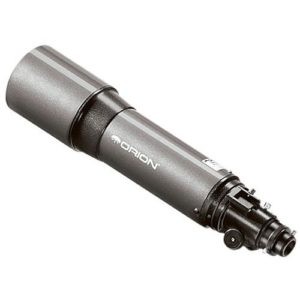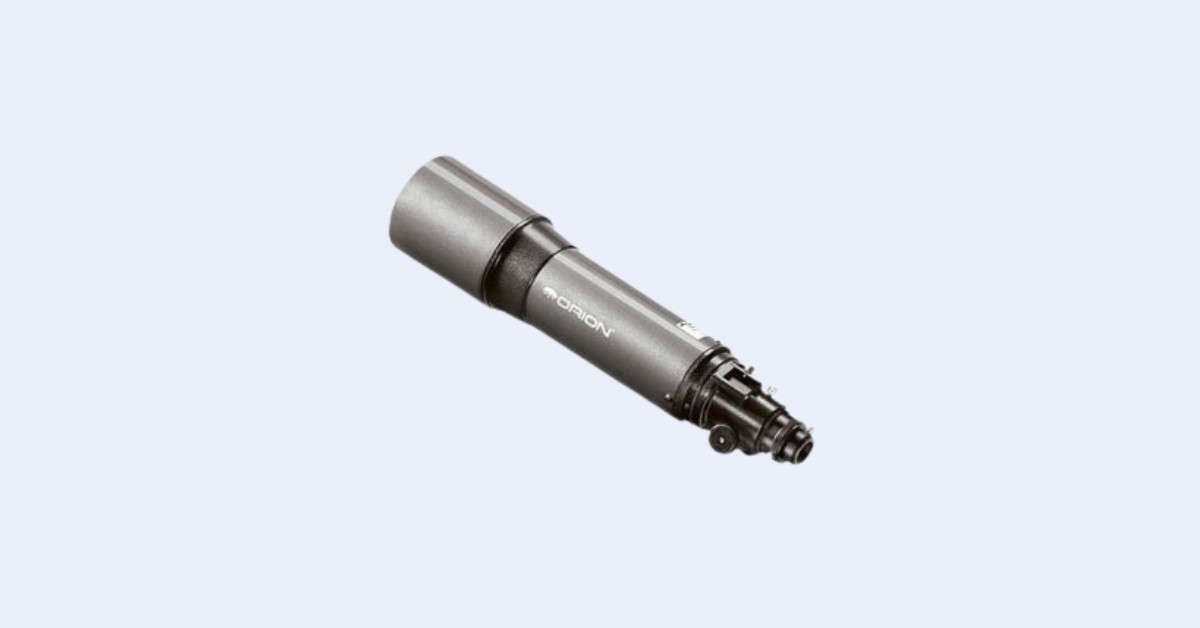Optics Performance Of Orion Astroview 120ST
The 120ST is a 120mm (4.72”) f/5 achromatic doublet refractor. Being a large f/5 achromat, I have noticed quite a lot of chromatic aberration displayed on the Moon, planets, and bright stars with the 120ST. This scope is really meant for low-power, wide-field deep-sky viewing, and not much else. However, images at high and moderate magnifications of the Moon and planets are acceptable for the casual observer. You are probably limited to less than 80x magnification before the chromatic aberration makes a mess of things.
The 120ST’s focuser is a rather simple, though thankfully all-metal in construction, 2” rack-and-pinion. While it’s great for holding heavy eyepieces or cameras, precise focusing can be somewhat difficult. A 1.25” adapter (though not a compression-ring design) is also included. The focuser also has a slot and thumbscrew to accept any finderscope or reflex sight with a Vixen/Synta-style compatible base.
With the included 1.25” diagonal and low-power eyepiece, the 120ST is capable of achieving a field of view as large as 2.7 degrees – that’s about as wide as the Andromeda Galaxy, or about 5 and a half times the apparent width of the full Moon! With a 2” diagonal and eyepieces, the maximum possible field expands as large as 4.5 degrees. This makes it great for rich-field viewing of star clusters and large nebulae.
Accessories
The AstroView 120ST comes with a 1.25” prism star diagonal, two 1.25” Orion Sirius Plossl eyepieces (25mm and 10mm providing 24x and 60x respectively), and a 6×30 finderscope for aiming the telescope. These are all pretty good – the Plossls are arguably all you need with a scope like this due to its large amount of chromatic aberration at high powers and its super short focal length. The 6×30 finder is not the best, but it’s sufficient for aiming the 120ST for the most part.
The AstroView EQ4 Mount

The AstroView mount is a fairly standard EQ4/EQ3 mount that derives from the Vixen Polaris mounts that debuted around 40 years ago. The EQ4, unlike smaller and cheaper equatorial mounts, is nearly entirely made out of aluminum – without the plastic brackets, gearing, and other parts that plague lower quality equatorial mounts. It includes a built-in polar scope for accurate polar alignment, as well as slow motion controls for both the right ascension and declination axis. It comes with 2 counterweights to balance with the 120ST, though you can really get away with only one weight if you put it at the very end of the counterweight shaft.
Overall the AstroView mount is pretty well-made, though the ergonomics of using it with a wide-field telescope are not really the best.
Should I buy a used AstroView 120ST?
A used AstroView 120ST would not be a bad scope, and given that it’s an entirely manual instrument and a refractor even one in relatively poor condition is likely to be fine other than cosmetic issues and perhaps needing lubricants on the focuser and mount gears.
Alternative Recommendations
There are a few scopes in the 120ST’s price range you might want to consider, all of which are bigger, better, and arguably easier and more convenient to set up and use:
- Apertura AD10/Zhumell Z10/Orion SkyLine 10 – These scopes have more than twice the aperture of the AstroView 120 giving bigger and brighter views, as well as sharper thanks to having double the resolution and no chromatic aberration.
- Orion XT8i – The XT8i is a bit more portable than a 10” Dobsonian but features Orion’s IntelliScope computerized object locating system which makes finding targets to view even easier. It still features significantly more aperture and thus brighter, bigger and sharper views than the AstroView 120ST.
- Celestron NexStar 6SE – The 6SE has quite a narrow field of view due to its longer focal length, but its fully computerized mount is a breeze to find objects with, it has roughly the same effective aperture as the 120ST, and it blows away the 120ST’s views of planets, globular clusters, and other smaller targets.
Aftermarket Accessory Recommendations
The main additional accessory that might be worth picking up for the 120ST is Orion’s motor drive for the AstroView mount. Orion offers both single-axis and dual-axis options – the former merely tracks the sky, while the latter gives you push-button controls for the mount replacing the manual slow-motion cables/knobs.
A 2” diagonal and wide-angle eyepiece will give you a wider field of view for deep-sky objects with the 120ST, but keep in mind that these might add up to costing nearly as much as the telescope itself. Higher magnification eyepieces are not really advisable due to the 120ST as it just doesn’t handle magnifications above 80x or so particularly well.
What can you see?
The AstroView 120ST excels at viewing large deep-sky objects like star clusters, the largest emission nebulae, and dark nebulae if you’re fortunate enough to have dark skies. But globular clusters are likely to remain little more than fuzzy balls, while most galaxies are smudges – though a few like M31 and M82 might show dust lanes under decent skies. M51’s spiral arms are just out of reach even with dark skies. And with loads of chromatic aberration, you’ll have trouble splitting many double stars.
The 120ST can show you the basic features of the Moon and planets, but not with the clarity of most other scopes of its size due to the amount of chromatic aberration. You’ll be able to see Jupiter’s cloud bands and maybe the Great Red Spot, but no shadow transits. Saturn’s rings and a few of its moons are visible, and you might see a few dark spots or at least the ice cap on Mars. Venus’ phases are no problem; Mercury’s might be too hard to spot. Uranus and Neptune are just bluish, star-like dots.
Astrophotography
The 120ST is theoretically usable for some basic deep-sky astrophotography, but with some caveats. For one thing, you’ll of course need some sort of motor drive, preferably one of the ones Orion sells. Second, the AstroView mount can’t be autoguided – and while it’s well-made for visual use with a 5” telescope, it’s arguably undersized for long-exposure astrophotography. Third – while the 120ST’s f/5 focal ratio of f/5 makes for fast exposure times, the large amount of chromatic aberration is especially obnoxious in photos, creating huge blue halos around bright stars. The AstroView 120ST might be a good learning tool, but for serious deep-sky astrophotography, you’ll want a GoTo equatorial mount capable of being guided and an apochromatic refractor or Newtonian reflector to start with.




I have the 120st. It’s my primary imaging scope
Granted the CA on bright things is a major issue. If you stay with what it’s designed for, this little fast acro can perform.